Library
All resources
1641 – 1660 of 2424 results

Building on social protection systems for effective disaster response: the Philippines experience
Report
How can social protection systems be used in disasters, as a complement to, or substitute for, humanitarian assistance? Oxford Policy Management led a two-year research project investigating this question, looking at the role of social protection in both mitigating the impact of large-scale shocks and...
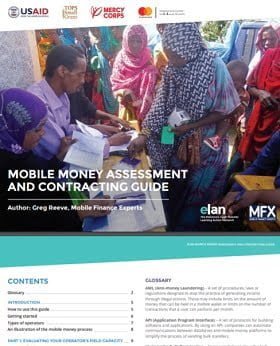
Mobile money assessment and contracting guide
Guidelines and Tools
Mobile money offers tremendous potential to enable cash transfers at scale and connect program participants to financial services. Oftentimes, however, humanitarian practitioners struggle to understand mobile money terminology to confidently evaluate different mobile money operators and to design...

Cash Transfer – Ppost WHS Discussions
Report
Topics Global updates on cash (including Grand Bargain, WHS Call to Action) Update on cash working group mapping project

Literature review on the Use of Cash in Shelter
Report
The Global Shelter Cluster (GSC) with support from UNHCR conducted this literature review of the use of cash in shelter programming to help assess how much documented evidence was currently available from within the sector. The objective of this study is to help better prepare the GSC and its members to...
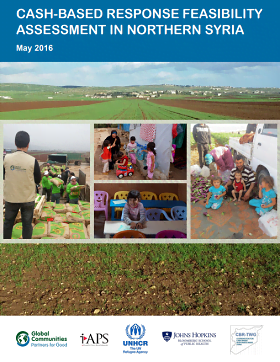
Cash-based Response Feasibility Assessment in Northern Syria
Case Study
As the conflict in Syria extends beyond the fourth year, there is need for a widespread humanitarian response focused on urban areas that addresses humanitarian needs and promotes resilience for the 13.5 million people in need of protection and humanitarian assistance within Syria. The majority of...
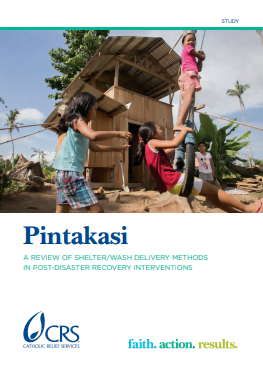
Pintakasi. A review of shelter/Wash delivery methods in post-disaster or recovery interventions
Report
Catholic Relief Services conducted an in-depth study to assess the efficiency, effectiveness and appropriateness of the modalities for delivering shelter and Wash assistance in its Typhoon Haiyan Recovery Program. This study, Pintakasi hopes to contribute valuable lessons learned and share best...
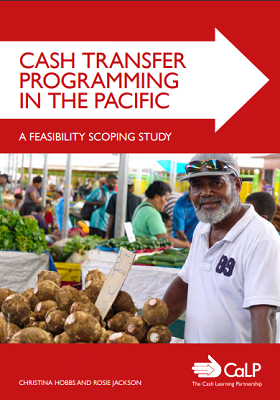
Cash transfers programming in the Pacific: A Feasibility Scoping Study
Report
The use of Cash Transfer Programming (CTP) to provide humanitarian assistance so that people may access the goods and services they need before, during and following a crisis has been gaining momentum over the past decade. Despite the considerable use of cash and vouchers by government and non-state...
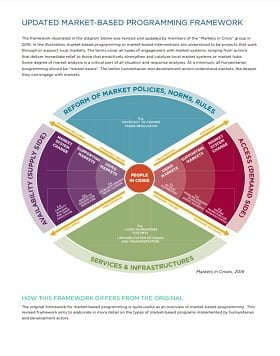
Updated Market-Based Programming Framework
Guidelines and Tools
The Market Based Programming framework was designed to help humanitarian actors understand market approaches in fragile contexts. Some degree of market analysis is a critical part of all situation and response analyses. At a minimum, all humanitarian programming should be “market aware”. The better...

Organizational Capacity Assessment Tool (OCAT) User Guide
Report
The Organizational Capacity Assessment Tool (OCAT) comprises a User Guide, Tool Worksheets for use in scoring and graphing results respectively, and a Recommendations Matrix. Assessment is done in six categories of organizational capacity, each with a series of criteria. Discussion and scoring on each of...

Data management and protection starter kit: Tip sheet 1: Privacy Impact Assessment (PIA)
Guidelines and Tools
A Privacy Impact Assessment (PIA) is a systematic analysis of the potential privacy risks related to data collected during program implementation. A PIA analyzes threats and risks to program data, including any legal and environmental factors, and develops mitigation strategies. PIAs help humanitarians...

Post Distribution Monitoring Report: Cash Based Interventions in Lebanon (Jan-March 2016)
Report
This post-monitoring report relies on several quantitative and qualitative approaches to evaluate the process, performance and impact of the cash based interventions (CBI) undertaken between January and March 2016, contrasting these with the results obtained in the post-distribution monitoring report...

What to know: working with humanitarians on e-cash programs
Report
International humanitarian assistance rose to a record US$24.5 billion in 2014. The 2015 Global Humanitarian Assistance Report indicated that over US$200 million of this was used in cash and voucher programs. An increasing number of humanitarian actors have begun to deliver cash electronically, through...

Mobile Money Transfers – For Humanitarian Assistance & Development Programming: Service Provider Perspective
Report
This report summarizes findings from research on how digital payment services providers in Africa have worked with Non-Governmental Organization (NGO) customers to deliver digital payments to their program participants/beneficiaries in the context of providing humanitarian assistance and/or for...
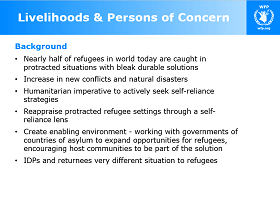
Livelihoods & Persons of Concern
Report
Nearly half of refugees in world today are caught in protracted situations with bleak durable solutions Increase in new conflicts and natural disasters Humanitarian imperative to actively seek self-reliance strategies Reappraise protracted refugee settings through a self-reliance lens Create enabling...

Development of Training Modules on the Fundamental Concepts of Cash and Voucher Programming
Guidelines and Tools
The CALP Network is in its first year of a 5 year strategy. The first year has been marked by opening up the CALP Network’s membership to its wider community of practice, with a significant growth in membership expected in 2016,
the development of a Board of Directors, made up of up to 13...
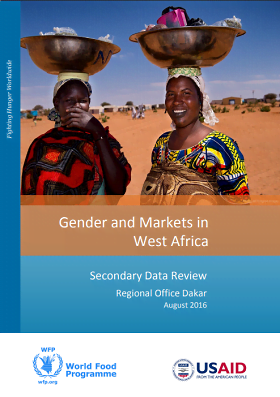
Gender and Markets in West Africa – Secondary Data Review
Report
The secondary information and data review presented here covers all gender and markets assessments conducted by WFP in West Africa, and market assessments conducted by key partners in the region over the past 5 years. The quality of the compiled assessments is reviewed to identify data and information...
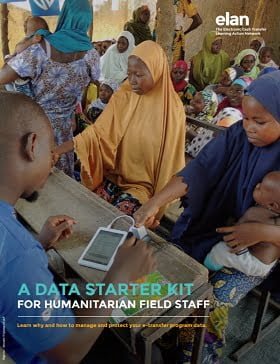
Data Starter Kit for Humanitarian Field Staff
Guidelines and Tools
A practical guide to help humanitarian field staff understand and manage data protection issues.

The Impact of Earned and Windfall Cash Transfers on Livelihoods and Conservation in Sierra Leone
Report
This study by Bulte et al. measures the impact of a cash transfer programme aimed at alleviating poverty and reducing pressure on the natural environment in Sierra Leone. Researchers offered aid to 91 rural communities, which are dependent on slash-and-burn agriculture in three forms: as windfall...
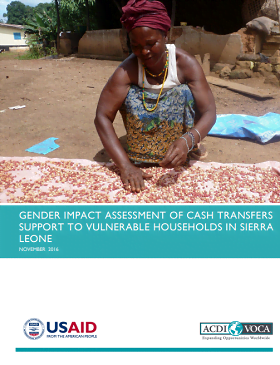
Gender impact assessment of cash transfers support to vulnerable households in Sierra Leone
Report
This report outlines the findings and recommendations from a qualitative assessment carried out to complement and further develop the findings from a recently concluded quantitative study of SNAP+ in order to better understand the driving factors behind behavior during the Ebola crises. The quantitative...

Evaluation of the Kenya Hunger Safety Net Programme Phase 2
Report
The report summaries key findings from Hunger Safety Net Programme Phase 2 Qualitative impact study conducted in August 2016. The report integrates interesting infographics that depict the findings in an easy to read and understand format